Signs of the Stocks Bull Market Top, Ringing Bear Market Bell
Stock-Markets / Stocks Bear Market Aug 17, 2013 - 05:06 PM GMTBy: John_Mauldin
 The investment media seems obsessed with the question of whether the Fed will taper. The real question should be not about "tapering" but about credibility. What happens when fundamentals become the narrative as opposed to what the central bank is doing? What happens if the Federal Reserve throws a liquidity party and nobody comes? Today we look at some of the fundamentals. The market is in fact overvalued, but that doesn't mean it can't become more overvalued. Is this August 1987 or August 1999?
The investment media seems obsessed with the question of whether the Fed will taper. The real question should be not about "tapering" but about credibility. What happens when fundamentals become the narrative as opposed to what the central bank is doing? What happens if the Federal Reserve throws a liquidity party and nobody comes? Today we look at some of the fundamentals. The market is in fact overvalued, but that doesn't mean it can't become more overvalued. Is this August 1987 or August 1999?
Before we delve into that question, let me fix a problem. Last week I mentioned a great strategy paper authored by my good friend Jon Sundt, President and CEO of Altegris. I failed to include the link. Here is the link. I encourage anyone who is looking to diversify into alternative investments to read it.
Signs of the Top
We are told they don't ring a bell when bull or bear markets start. That may be true, but it does seem that there are similar signs as we approach turning points. This week in my reading I have been struck by a number of signs that suggest that, if we haven't reached a top in the latest bull market cycle, at least a pause may be in order. Let's review a few of them. The first comes from Charles Gave, who notes that margin debt is now back to extremes.
I started in the fascinating business of trying to understand why markets go up and down in February 1971. The old money manager in the French bank which had hired me straightaway said: "Charles, you will never get rich in this business using other people's money. Do NOT leverage your positions. Leverage might be all right for fellows who deal in real estate, but for those in stock markets, it only brings misery."
Being young and smart (or so I thought), I assumed this advice could not conceivably apply to me. A few margin calls later, accompanied by quite a string of sleepless nights, and I came to realize that the old gentleman had a point.
Now that I am quite old myself and certainly not as smart as I thought I was in 1971, I find myself tracking the moves of the poor souls who believe they can leverage profitably. Then I do the opposite. This is why Charles the 70-year-old is watching what Charles the 30-year-old is doing—to do the reverse. Have a look at the graph.
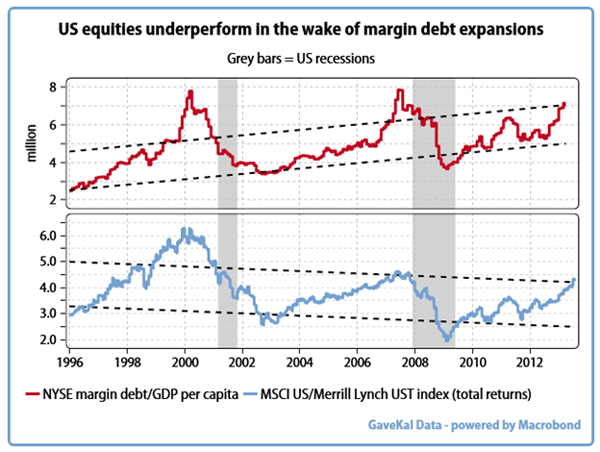
The red line at the top is New York Stock Exchange margin debt as a multiple of US GDP per capita, the black line on the bottom pane is a ratio between US stocks and (government) bonds. It seems that the fellows using other people's money to get rich have an uncanny ability to leverage up when shares become overvalued vs. bonds. They also seem to get most enthusiastic just before a recession, usually after a prolonged outperformance of equities against bonds.
They leverage in order to participate as much as possible in what looks like a free ride, with no downside risk. There are always a number of good reasons why the stock market cannot change direction. Take your pick: "technology has created a new type of economy," or "house prices never go down," or "we have recently discovered an infinite source of wealth called QE." These reasons can be added to a long roster of other excuses such as, "I can get insurance against the next market decline" (1987) or "the Fed will never, ever allow for positive real rates to appear" (1979) or "oil prices cannot quadruple" (1974).
The rise in the stock market this past year has not been because of fundamentals. Earnings in the nonfinancial sector have been flat. Mark Gongloff writes on the HuffPost site:
Bloomberg figures that bank earnings rose 27% in the second quarter, which was the only thing keeping the S&P 500 from reporting a net drop in profits for the quarter. With the banks, S&P 500 profits were up 3.3% in the quarter, Bloomberg estimates. Without them, S&P 500 profits would have been down 1.2%.
Lousy profits have not kept the S&P 500 from gaining nearly 19 percent so far this year. But even that performance trails the financial sector, which is up 26 percent this year. The banks topped the broader market last year, too, doubling the broader market's gain. And banks have managed all this despite never-ending scandals, onerous regulations and the scorn of an angry nation.
The Wall Street Journal suggests that non-financial companies might have finally reached the limit of how much profit they can squeeze out of a dour economy by laying off workers and cutting costs. Banks, on the other hand, have the useful ability to skim rent from even the lamest economy. They're proving it now and finding profits in innovative ways, like moving aluminum around in warehouses to create a sense of scarcity and drive up prices." (Huffington Post)
This lack of profits is showing up in the economy. Nominal GDP growth over the past year was the slowest ever recorded outside of a recession, as the following chart from the London Telegraph demonstrates.
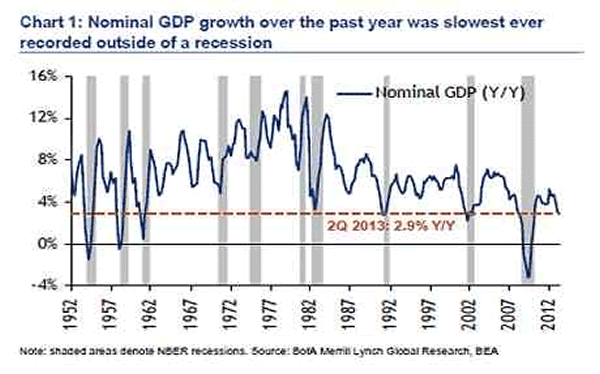
And because the rise in the stock market has not been accompanied by an increase in earnings, price-to-earnings ratios have risen back to levels that suggest the market is getting closer to stalling out. I post the following tables from the Wall Street Journal. While the Dow and the S&P 500 are not at nosebleed levels, they are certainly pricey. The Russell 2000 and the NASDAQ, on the other hand, are seriously overpriced in terms of earnings.
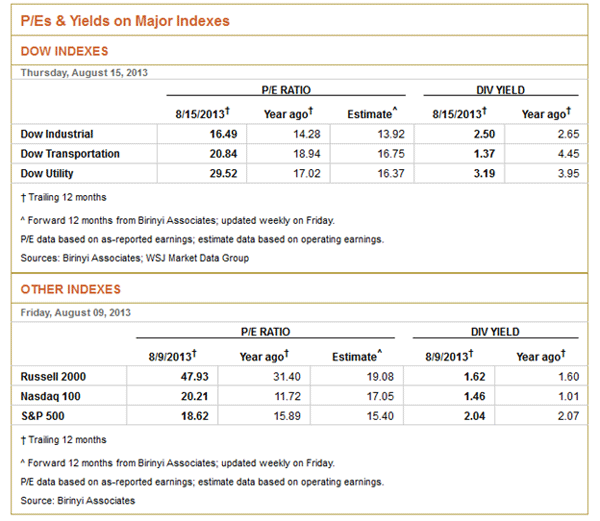
What Are They Smoking?
What I find most fascinating in the table is the estimate from Birinyi Associates of the forward 12-month earnings of the Russell 2000. On a trailing 12-month basis, the P/E ratio is nearly 48. However, Birinyi estimates that earnings are going to grow so much in the next 12 months that the forward P/E ratio will be merely 19. Yes, merely. They come up with that number by shifting from as-reported earnings for the previous 12 months to operating earnings for the next 12 months. I've written letters in the past demonstrating that "operating earnings" should be characterized as earnings before interest and hype. Call me a skeptic, but I just don't see any way you can publish a number like that with a straight face.
Is always instructive to pay attention to what Jeremy Grantham at GMO thinks about the prospects for future returns. Grantham manages over $100 billion and is an intellectual force in the investment community. Here are his recent expected returns for various asset classes relative to their valuations. They do not bode well for pension funds that are projecting 7 to 8% compound returns for the next seven years. This problem is magnified in public employee pension programs, some of which are already massively underfunded.
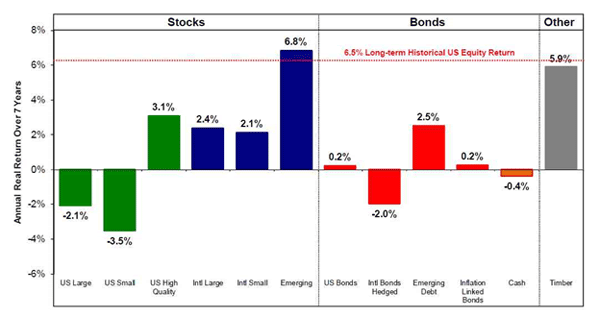
Finally, let's look at two charts that my good friend John Hussman has posted in the past few weeks. John is arguing that stocks are now overvalued, overbought, and overbullish.
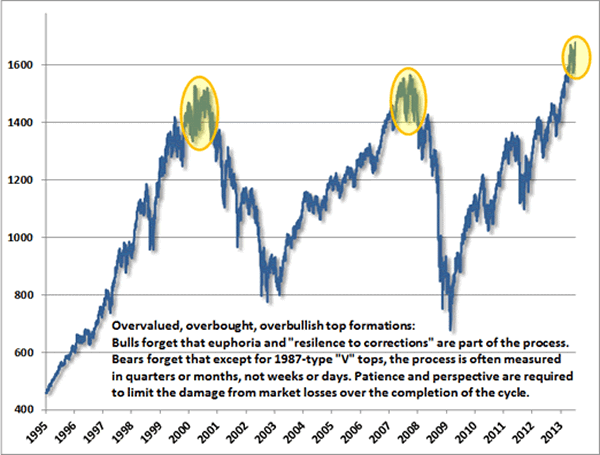
His second chart looks at two measures of valuation for the S&P 500 and compares them to the price level. One measure is a function of revenues, and the other is the smoothed Shiller earnings, which is an average of inflation-adjusted earnings from the previous 10 years. Note that the stock market is not at the bubble levels of 2000 in terms of valuation, but it is certainly getting close to 2006-07 levels.
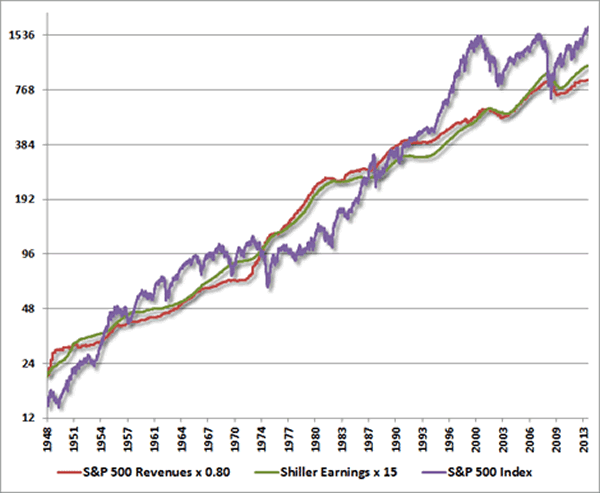
This is not to say the stock market can't continue to go up from here. The belief that one should not fight the Fed has become the dominant paradigm for the market. The fingerprints of QE3 are all over the recent rise in the stock market.
As Didier Sornette put it, writing about central bank responses to the crises of the past few decades, "Each excess was felt to be 'solved' by measures that in fact fueled following excesses; each crash was fought by an accommodative monetary policy, sowing the seeds for new bubbles and future crashes."
How will it all end? Faith in central banks today is equivalent to faith in the word dot-com in 1999 or faith in the eternal rise of housing prices in 2006. With the support of a powerful narrative—that central banks can support asset prices and effectively backstop financial crises (eliminating tail risk)—sentiment is driving the markets higher in the face of cyclically improving but historically weak and unstable fundamentals (plagued by debt deleveraging and aging demographics).
Ultimately, the stability of the system depends on central banks' credibility, markets'sentiment, and policy responsiveness to prevent minor drawdowns from becoming full-blown crashes. My friend Mohamed El-Erian has written extensively on the importance of the central bank "brand" and warned of the danger of a broken narrative. Markets tend to overshoot in both directions and will most likely fall even farther than fundamentals warrant when and if central banks lose control of popular sentiment.
It is not only the credibility of sovereign nations burdened with debt that can reach a Bang! moment. The credibility of and faith in central banks is just as fragile. Today we see humorous images of dollar bills with Ben Bernanke's face on them, with the words "In Ben We Trust." Unfortunately there is truth in that jest. Whether it is Mark Carney at the BOE or Mario Draghi at the ECB or the future chairperson of the Fed, central bankers are in the hot seat when it comes to global stability. The world no longer worries first and foremost about the products corporations make or the services they perform. Rather, it is focused on the amount of easy money the central banks can dish out.
What happens when that amount is no longer enough and market forces turn? With central banks already in a hyper-easing mode, what can they do then, in the face of the next real crisis, to convince the markets that they have things under control? And there are any number of potential trigger points for the next crisis. One that comes to mind is a political shock such as a southern European country's refusing to submit to further austerity (if Italy or will Spain is forced into early elections, that could do it) or a change in Germany's tune. What if the ECB actually has to follow through on its commitment to use OMT (outright monetary transactions) to buy unlimited amounts of short-term Italian, Spanish, and/or French bonds. Draghi simply cannot follow through without expanding the ECB's balance sheet, and it is not crazy to think that the German Constitutional Court could respond by limiting the size of OMT, as it did with EFSF. That kind of blow would mea n game over for Draghi's sentiment-supporting bluff.
If the narrative of the power of central banks changes, then it is a whole new ballgame for investors. Fundamentals will once again rule. What a concept. You might want to consider raising a little cash in your portfolio or buying some volatility insurance. Just a thought…
Join Me at the World Premier of Money For Nothing
I am extremely pleased to be able to announce the world premiere of the extraordinary new documentary on the Federal Reserve, called Money for Nothing. The screening will be in Dallas on Friday, September 6, at 7 PM at AMC NorthPark 15. The movie will then begin to open in various cities around the country the following week, starting with New York and Washington, DC. I was privileged to see the full film last week in Maine with many of my economist friends, and everyone was impressed. This is a movie that I hope everyone in the United States will watch so they can understand the history behind the Federal Reserve and what is happening now. Producer Jim Bruce was able to interview dozens of luminaries from both inside and outside the Federal Reserve system, including Paul Volcker, Janet Yellen, numerous regional presidents, and former Federal Reserve members. You can see a trailer by c licking here and learn when the movie is coming to a city near you, or you can arrange for it to do so, by going to www.MoneyForNothingTheMovie.org. I hope you can join me at the world premiere in Dallas. It will be a special evening.
Chicago, Bismarck, Denver, Toronto, and New York
On Tuesday, September 10, in Chicago, I will be joining my longtime friend and partner Steve Blumenthal to present my most recent thoughts on the economy, the Fed, and the direction of interest rates and their impact on the economy and equity markets at the Trinity Financial Advisors Investor Forum, hosted by John Wimbiscus. The Forum will be held at 6:30 PM at the Gleacher Center at the University of Chicago, located at 450 North Cityfront Plaza Drive, Chicago, IL 60611. Please contact Linda Cianci at linda@cmgwealth.com or call 610-989-9090 x140 to reserve a seat. I hope to see you there.
I will be traveling from there to Bismarck, North Dakota, to delve deeper into the Bakken shale oil boom and to speak for BNC Bank on September 12. My great friend Dr. Lacy Hunt will also be presenting. If you are in the area, you should plan to attend. Then I will be in Denver with my partners at Altegris Investments on September 19 for a presentation to clients and prospects before flying to Toronto to be with my good friend Louis Gave for a morning seminar on September 23. Please note that last week I said that seminar was in August, so I created some unnecessary confusion. If you would like to attend, you can register at http://gavekal.com/seminar.cfm or contact Chris Lightbound with any questions. From Toronto I will fly on to New York City for a few days of media and meetings. While that schedule may seem busy, it involves only about 10 nights away fro m home for the month, which is less than half of what I've been doing for the last year. I guess it's all relative.
After a long day of travel from Montana, I'm back at my apartment in Dallas and finishing the letter. It has been a very relaxing week working from the deck of my friend Darrell Cain's summer home overlooking Flathead Lake. It is a beautiful part of the world, and I was amazed at how relatively little boat traffic there was on the lake. But then, Flathead Lake is not a hop, skip, and jump from a major population center. You have to really want to get there in order to comprehend the beauty. Darrell has been trying to get me to come up for years, and I now understand why he spends two summer months a year in Montana.
Steve Cucchiaro of Windhaven (who now manages about $17 billion at Schwab) joined us for three days and nights. We spent a great deal of time looking at nonlinear dynamic-systems analysis of the markets, which may not be your usual conversation on a summer evening, but it is one that I found fascinating. The world has become exceedingly complex: standard, backward-looking correlation analysis simply doesn't cut it anymore.
It is time to hit the send button. I'll be home for two weeks and trying to catch up on a hundred details, as well as to get into the gym and drop a few pounds. And I get to catch up with my kids and grandkids, too. Have a great week and enjoy the final month of summer.
Your ready to be home for a while analyst,
John Mauldin
subscribers@MauldinEconomics.com
Outside the Box is a free weekly economic e-letter by best-selling author and renowned financial expert, John Mauldin. You can learn more and get your free subscription by visiting www.JohnMauldin.com.
Please write to johnmauldin@2000wave.com to inform us of any reproductions, including when and where copy will be reproduced. You must keep the letter intact, from introduction to disclaimers. If you would like to quote brief portions only, please reference www.JohnMauldin.com.
John Mauldin, Best-Selling author and recognized financial expert, is also editor of the free Thoughts From the Frontline that goes to over 1 million readers each week. For more information on John or his FREE weekly economic letter go to: http://www.frontlinethoughts.com/
To subscribe to John Mauldin's E-Letter please click here:http://www.frontlinethoughts.com/subscribe.asp
Copyright 2013 John Mauldin. All Rights Reserved
Note: John Mauldin is the President of Millennium Wave Advisors, LLC (MWA), which is an investment advisory firm registered with multiple states. John Mauldin is a registered representative of Millennium Wave Securities, LLC, (MWS), an FINRA registered broker-dealer. MWS is also a Commodity Pool Operator (CPO) and a Commodity Trading Advisor (CTA) registered with the CFTC, as well as an Introducing Broker (IB). Millennium Wave Investments is a dba of MWA LLC and MWS LLC. Millennium Wave Investments cooperates in the consulting on and marketing of private investment offerings with other independent firms such as Altegris Investments; Absolute Return Partners, LLP; Plexus Asset Management; Fynn Capital; and Nicola Wealth Management. Funds recommended by Mauldin may pay a portion of their fees to these independent firms, who will share 1/3 of those fees with MWS and thus with Mauldin. Any views expressed herein are provided for information purposes only and should not be construed in any way as an offer, an endorsement, or inducement to invest with any CTA, fund, or program mentioned here or elsewhere. Before seeking any advisor's services or making an investment in a fund, investors must read and examine thoroughly the respective disclosure document or offering memorandum. Since these firms and Mauldin receive fees from the funds they recommend/market, they only recommend/market products with which they have been able to negotiate fee arrangements.
Opinions expressed in these reports may change without prior notice. John Mauldin and/or the staffs at Millennium Wave Advisors, LLC and InvestorsInsight Publishing, Inc. ("InvestorsInsight") may or may not have investments in any funds cited above.
Disclaimer PAST RESULTS ARE NOT INDICATIVE OF FUTURE RESULTS. THERE IS RISK OF LOSS AS WELL AS THE OPPORTUNITY FOR GAIN WHEN INVESTING IN MANAGED FUNDS. WHEN CONSIDERING ALTERNATIVE INVESTMENTS, INCLUDING HEDGE FUNDS, YOU SHOULD CONSIDER VARIOUS RISKS INCLUDING THE FACT THAT SOME PRODUCTS: OFTEN ENGAGE IN LEVERAGING AND OTHER SPECULATIVE INVESTMENT PRACTICES THAT MAY INCREASE THE RISK OF INVESTMENT LOSS, CAN BE ILLIQUID, ARE NOT REQUIRED TO PROVIDE PERIODIC PRICING OR VALUATION INFORMATION TO INVESTORS, MAY INVOLVE COMPLEX TAX STRUCTURES AND DELAYS IN DISTRIBUTING IMPORTANT TAX INFORMATION, ARE NOT SUBJECT TO THE SAME REGULATORY REQUIREMENTS AS MUTUAL FUNDS, OFTEN CHARGE HIGH FEES, AND IN MANY CASES THE UNDERLYING INVESTMENTS ARE NOT TRANSPARENT AND ARE KNOWN ONLY TO THE INVESTMENT MANAGER.
John Mauldin Archive |
© 2005-2022 http://www.MarketOracle.co.uk - The Market Oracle is a FREE Daily Financial Markets Analysis & Forecasting online publication.



